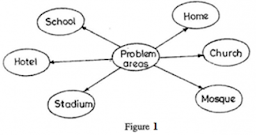BECE 2014 BDT (Home Economics) Paper 1 Objectives
BECE PAST QUESTIONS AND ANSWERS
BASIC DESIGN AND TECHNOLOGY (BDT)
BECE 2014 BDT (Home Economics) Paper 1
OBJECTIVES
1. To hold a lining onto a fabric temporarily, one can use
A. basting
B. even tacking
C. tailor’s tacks
D. thread marking
2. Which of the following stitches can be used to neaten raw edges of a set-in-sleeve?
A. Feather
B. Fishbone
C. Herringbone
D. Loop
3. The goitre on Evelyn’s neck is caused by lack of
A. calcium
B. iodine
C. protein
D. vitamin
4. Man-made elements represented in art include
A. branches
B. rivers
C. stones
D. walls
5. The visitors’ book signed at exhibitions helps the exhibitor to know the
A. dignitaries who attended
B. number of works in high demand
C. observations made about the work
D. people who came
Use the sketch below to answer questions 6 and 7
6. Which of the following represents the front view in the direction of arrow Z?
7. Which of the following represents the left end elevation in the direction of arrow X?
8. A place where art works are sold is
A. an archive
B. a gallery
C. a museum
D. a studio
9. In design, the conditions that the final solution must satisfy is termed
A. investigation
B. specification
C. development
D. analysis
Figure 2 is a block. Use it answer questions 10 and 11
10. Which of the following instruments is most suitable for drawing horizontal lines?
A. Tee-square
B. Protractor
C. Compass
D. Set-square
11. Figure 1 shows the method of
A. specifying solutions
B. stating specification
C. evaluating artifact
D. identifying needs
12. Which of the following design process stages follows the method shown in figure 1?
A. Writing specifications
B. Writing situation
C. Analyzing a situation
D. Sketching possible solutions
13. Shading with lines is described as
A. cross hatching
B. hatching
C. stippling
D. tonal value
14. Which of the following colours produces a feeling of warmth?
A. Blue
B. Green
C. Violet
D. White
15. Which of the following factors can cause a sewing business to collapse?
A. Advertising
B. Insurance
C. Low sales
D. Skilled labour
16. Which of the following tools is used for drawing lines when drafting patterns?
A. A pair of dividers
B. A protractor
C. Metre rule
D. Tape measure
17. It is better to use cotton fabrics for making specimen because it is
A. beautiful
B. dirt resistant
C. durable
D. easy to handle
18. All vegetable fibres leave ………………….. when burnt.
A. ashes
B. charcoal
C. hard ball
D. soft ball
19. The most suitable fabric for making a bed sheet is
A. cotton
B. nylon
C. rayon
D. silk
20. One can make an embroidered table runner if he or she learns
A. designing
B. drawing
C. sewing
D. weaving
21. Which of the following measurement is needed when making a boy’s pair of shorts?
A. Back length
B. Chest
C. Crotch
D. Width
22. The commonest collar on babies’ garment is
A. Chinese
B. Peterpan
C. Shawl
D. Shirt
23. Which of the following are portions of control equipment?
I. Measuring cups
II. Weighing scales
III. Polythene bags
IV. Empty tins
A. I, II and III only
B. I, II and IV only
C. I, III and IV only
D. II, III and IV only
24. Choice of equipment and tools is based on
A. how difficult to clean and maintain
B. lack of space for storage
C. life span of equipment
D. unavailability of spare parts
25. Moist heat causes ………………… to the human skin.
A. bruises
B. burns
C. cuts
D. scalds
26. Food preservation is the treatment given to foods to enable them stay fresh for
A. a long time
B. some days
C. three days
D. three weeks
27. The method of cooking in which heat travels directly to the food is
A. baking
B. boiling
C. grilling
D. stewing
28. The method of cooking which is fast but expensive to use is
A. boiling
B. frying
C. grilling
D. roasting
29. Which of the following are reasons for cooking food? To
I. help food digest faster
II. make the food edible
III. make the food soft
IV. make the food last longer
A. I, II and III only
B. I, II and IV only
C. I, II and IV only
D. II, III and IV only
30. The most important factor to consider when planning meals is the
A. appearance of the food
B. family budget
C. food available
D. service of the food



.webp)








No comments: